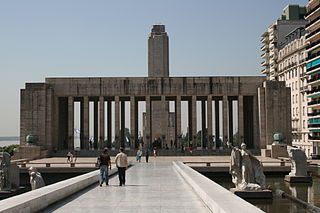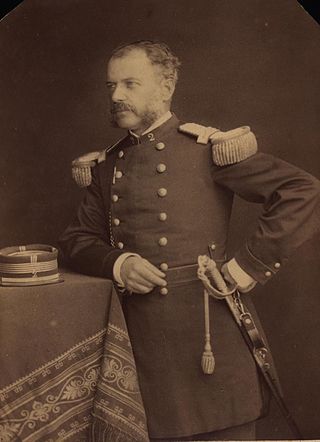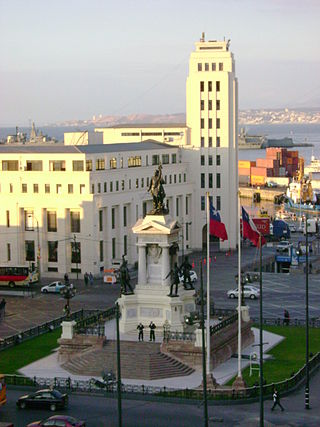
The Chilean Navy is the naval warfare service branch of the Chilean Armed Forces. It is under the Ministry of National Defense. Its headquarters are at Edificio Armada de Chile, Valparaiso.

Iquique is a port city and commune in northern Chile, capital of both the Iquique Province and Tarapacá Region. It lies on the Pacific coast, west of the Pampa del Tamarugal, which is part of the Atacama Desert. It has a population of 191,468 according to the 2017 census. It is also the main commune of Greater Iquique. The city developed during the heyday of the saltpetre mining in the Atacama Desert in the 19th century. Once a Peruvian city with a large Chilean population, it was conquered by Chile in the War of the Pacific (1879–1883). Today it is one of only two free ports of Chile, the other one being Punta Arenas, in the country's far south.

The National Flag Memorial in Rosario, Argentina, is a monumental complex built near the shore of the Paraná River. It was inaugurated on June 20, 1957, the anniversary of the death of Manuel Belgrano, creator of the Argentine flag, who raised it for the first time on an island on the opposite shore of the river on February 27, 1812.

Agustín Arturo Prat Chacón was a Chilean lawyer and navy officer. He was killed in the Battle of Iquique, during the War of the Pacific.

The Santa María School massacre was a massacre of striking workers, mostly saltpeter works (nitrate) miners, along with wives and children, committed by the Chilean Army in Iquique, Chile, on December 21, 1907. The number of victims is undetermined but is estimated to be over 2,000. The massacre occurred during the peak of the nitrate mining era, which coincided with the Parliamentary Period in Chilean political history (1891–1925). With the massacre and an ensuing reign of terror, not only was the strike broken, but the workers' movement was thrown into limbo for over a decade. For decades afterwards, there was official suppression of knowledge of the incident, but in 2007 the government conducted a highly publicized commemoration of its centenary, including an official national day of mourning and the reinterment of the victims' remains.

Eleuterio Ramírez Molina was a Chilean lieutenant colonel. He founded the Foro Militar military newspaper in 1871.

The Plaza Mayor in Salamanca, Spain is a large plaza located in the center of Salamanca, used as a public square. It was built in the traditional Spanish baroque style and is a popular gathering area. It is lined by restaurants, ice cream parlors, tourist shops, jewelry stores and a pharmacy along its perimeter except in front of the city hall. It is considered the heart of Salamanca and is widely regarded as one of the most beautiful plazas in Spain. It is connected to the shopping area Calle del Toro from the northeast, Calle de Zamora from the north, the restaurants on Calle de Concejo from the northwest, Calle del Prior and the small Calle de la Caja de Ahorros from the west as well as Plaza del Corrillo from the south.
Baquedano Street is a long avenue in the old quarter of Iquique, Chile. It is a popular tourists attraction and is a “typical zone,” a status that preserves its historical and architectural heritage. It is characterized by its late 19th- and early 20th-century houses built of wood from Europe.

Esmeralda was a wooden-hulled steam corvette of the Chilean Navy, launched in 1855, and sunk by the Huáscar on 21 May 1879 at the Battle of Iquique during the War of the Pacific.

The Battle of Iquique was a naval engagement on 21 May 1879, during the War of the Pacific, where a Chilean corvette commanded by Arturo Prat Chacón faced a Peruvian ironclad under Miguel Grau Seminario. The battle occurred off the port of Iquique, Peru, and ended with the sinking of the Chilean wooden corvette Esmeralda by the Peruvian ironclad Huáscar after four hours of combat, marking a victory for Peru.

The Castle of Jimena de la Frontera is a castle located in Jimena de la Frontera, Spain. It was declared Bien de Interés Cultural in 1931.

The Leaning Tower of Zaragoza, sometimes called by its Spanish name, Torre Nueva, was a Mudéjar leaning tower located in current Plaza de San Felipe, in Zaragoza.

The Tarapacá campaign was a short stage of the War of the Pacific in the last months of 1879, after the Chileans won definitive naval superiority at Angamos. It took its name from the region where it was fought.

The Immaculate Conception Cathedral also called Iquique Cathedral It is a cathedral church of Catholic worship, home of the Roman Catholic Diocese of Iquique in the northern part of the South American country of Chile. It was consecrated in 1882 under the patronage of the Immaculate Conception of Mary.

The Plaza Sotomayor is a plaza in Valparaíso, Chile. It is named after Rafael Sotomayor. The square is lined by buildings occupying full block-fronts of the streets that flank it. The focus of the square is the monument that honors the Chilean sailors who fell during the Battle of Iquique and the Battle of Punta Gruesa. The plaza and surrounding buildings was designated a Zona Típica on January 23, 1979.

The UCV Clock Tower, also known by its Spanish name Torre del Reloj de la UCV, or Reloj de la UCV, is a monument made of prestressed concrete. It is by the Rectory Plaza of the Central University of Venezuela in the University City of Caracas, and was built between 1953 and 1954.

The iglesia San Ignacio, also known as iglesia del Colegio de San Ignacio, is a Roman Catholic church founded by the Society of Jesus in Santiago, Chile. It is next to the Colegio San Ignacio, and was declared as a National Historic Monument in 2002.

The Edificio de la Comandancia en Jefe de la Armada de Chile, also known as Edificio de la Intendencia de Valparaíso, because it was a purpose-built Intendencia, is a building designed in an eclectic style with Renaissance Revival architecture elements, which rises 5 floors in height and covers 8,000 square metres (86,000 sq ft). The main facade of the building faces the Plaza Sotomayor of Valparaíso and the Monument to the Heroes of Iquique.

The German Tower, also known as the Clock Tower or the University Clock, is a clock tower in the historic centre of Lima, Peru. It is located in front of the Casona de la Universidad Nacional Mayor de San Marcos, in the University Park at the intersection of Abancay and Nicolás de Piérola avenues. It was donated in 1921 by the German community in Lima, on the occasion of the Centennial of the Independence of Peru. At twelve in the day and at six in the afternoon, its chimes played the first stanza of the National Anthem of Peru.



















